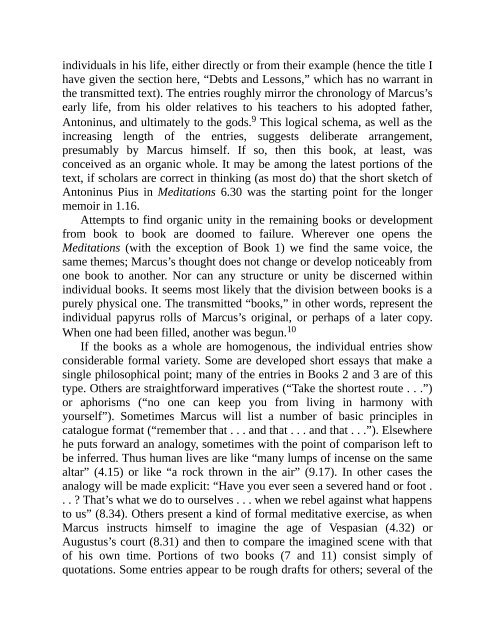9781945186240
You also want an ePaper? Increase the reach of your titles
YUMPU automatically turns print PDFs into web optimized ePapers that Google loves.
individuals in his life, either directly or from their example (hence the title I<br />
have given the section here, “Debts and Lessons,” which has no warrant in<br />
the transmitted text). The entries roughly mirror the chronology of Marcus’s<br />
early life, from his older relatives to his teachers to his adopted father,<br />
Antoninus, and ultimately to the gods. 9 This logical schema, as well as the<br />
increasing length of the entries, suggests deliberate arrangement,<br />
presumably by Marcus himself. If so, then this book, at least, was<br />
conceived as an organic whole. It may be among the latest portions of the<br />
text, if scholars are correct in thinking (as most do) that the short sketch of<br />
Antoninus Pius in Meditations 6.30 was the starting point for the longer<br />
memoir in 1.16.<br />
Attempts to find organic unity in the remaining books or development<br />
from book to book are doomed to failure. Wherever one opens the<br />
Meditations (with the exception of Book 1) we find the same voice, the<br />
same themes; Marcus’s thought does not change or develop noticeably from<br />
one book to another. Nor can any structure or unity be discerned within<br />
individual books. It seems most likely that the division between books is a<br />
purely physical one. The transmitted “books,” in other words, represent the<br />
individual papyrus rolls of Marcus’s original, or perhaps of a later copy.<br />
When one had been filled, another was begun. 10<br />
If the books as a whole are homogenous, the individual entries show<br />
considerable formal variety. Some are developed short essays that make a<br />
single philosophical point; many of the entries in Books 2 and 3 are of this<br />
type. Others are straightforward imperatives (“Take the shortest route . . .”)<br />
or aphorisms (“no one can keep you from living in harmony with<br />
yourself”). Sometimes Marcus will list a number of basic principles in<br />
catalogue format (“remember that . . . and that . . . and that . . .”). Elsewhere<br />
he puts forward an analogy, sometimes with the point of comparison left to<br />
be inferred. Thus human lives are like “many lumps of incense on the same<br />
altar” (4.15) or like “a rock thrown in the air” (9.17). In other cases the<br />
analogy will be made explicit: “Have you ever seen a severed hand or foot .<br />
. . ? That’s what we do to ourselves . . . when we rebel against what happens<br />
to us” (8.34). Others present a kind of formal meditative exercise, as when<br />
Marcus instructs himself to imagine the age of Vespasian (4.32) or<br />
Augustus’s court (8.31) and then to compare the imagined scene with that<br />
of his own time. Portions of two books (7 and 11) consist simply of<br />
quotations. Some entries appear to be rough drafts for others; several of the


